Baghali polo is a fresh, light, and delicious Persian mixed rice made with broad beans (typically fava), fresh dill, and a touch of garlic. It is a common dish in traditional Persian cuisine. When made with fresh fava beans from the pod or shell of the beans plus fresh dill weed, the process can be extremely labor-intensive (see the pic share of the day my mom insisted on making it the old fashion way with our girls). Here I share my time-saving tips and techniques for this old-world classic recipe. I often substitute green peas for fava beans (when fava beans are not in season) in this classic layered rice recipe.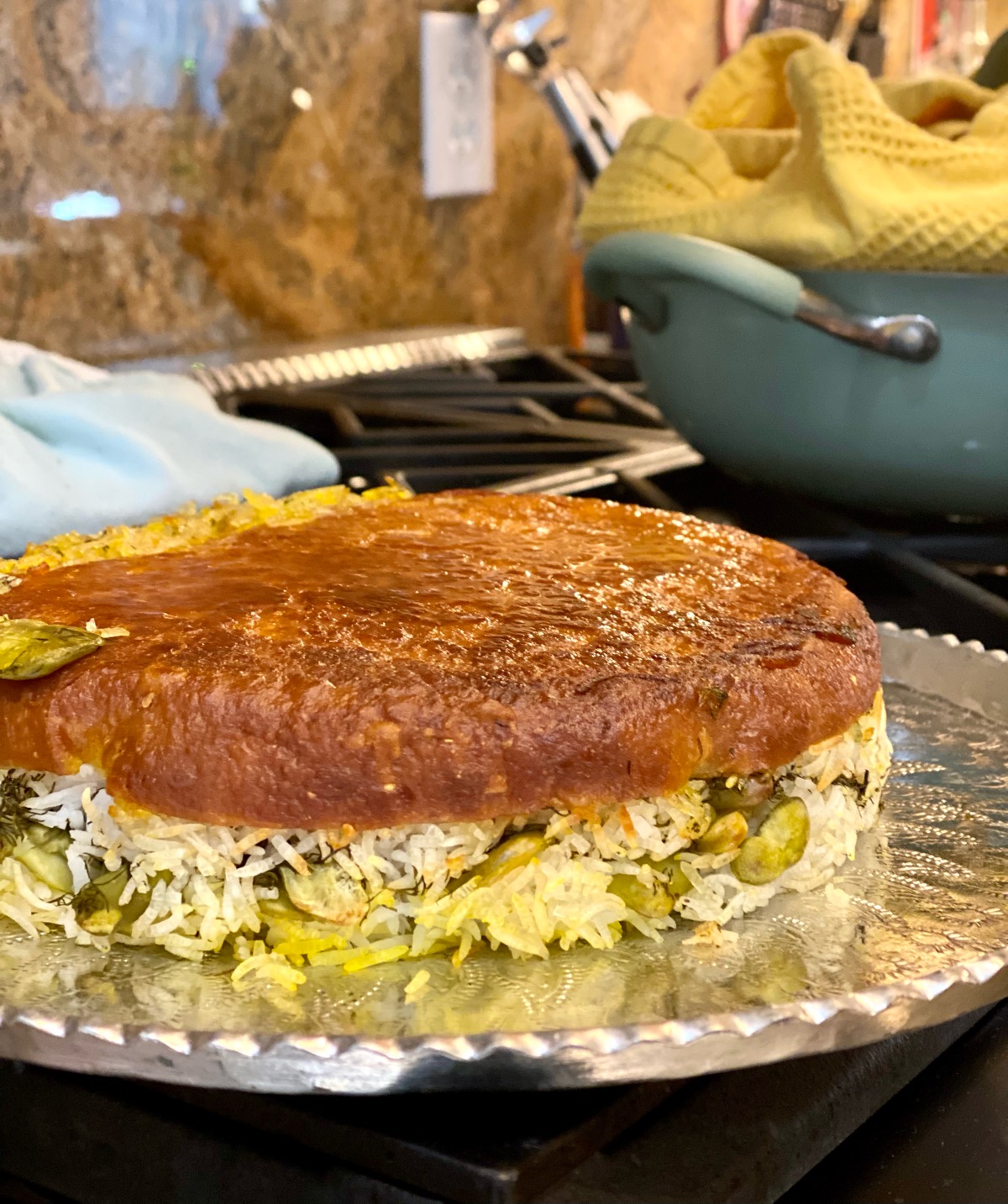
You may be asking what is a Persian ‘mixed rice’? We refer to mixed rice for all rice recipes where it’s necessary to parboil (or partially boil) the rice first, then add special add-in ingredients (usually vegetables, beans, legumes, herbs, and spices) for a particular rice dish – in this case with fava beans and dill.
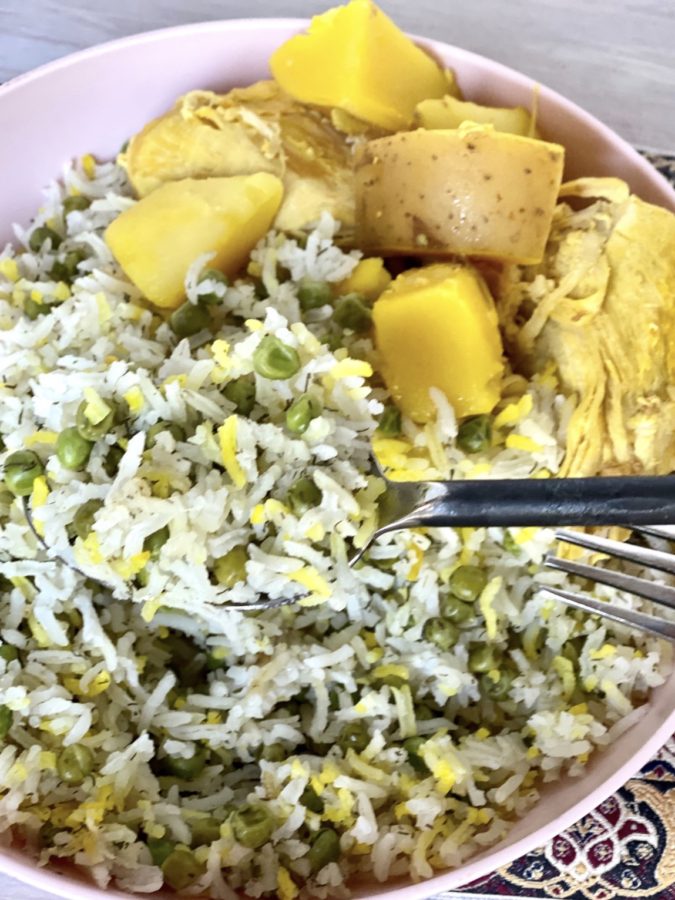
In this version, we substituted the fava beans with green peas and served it with a side of potatoes.
But first, a quick story – My favorite memory of eating baghali polo was with Leyla’s class way back when she was in elementary school. The science curriculum was developed and run by parents and it was simply called ‘garden’. In Garden, the kids had the opportunity to cook with what they planted, cultivated, grew, and harvested.
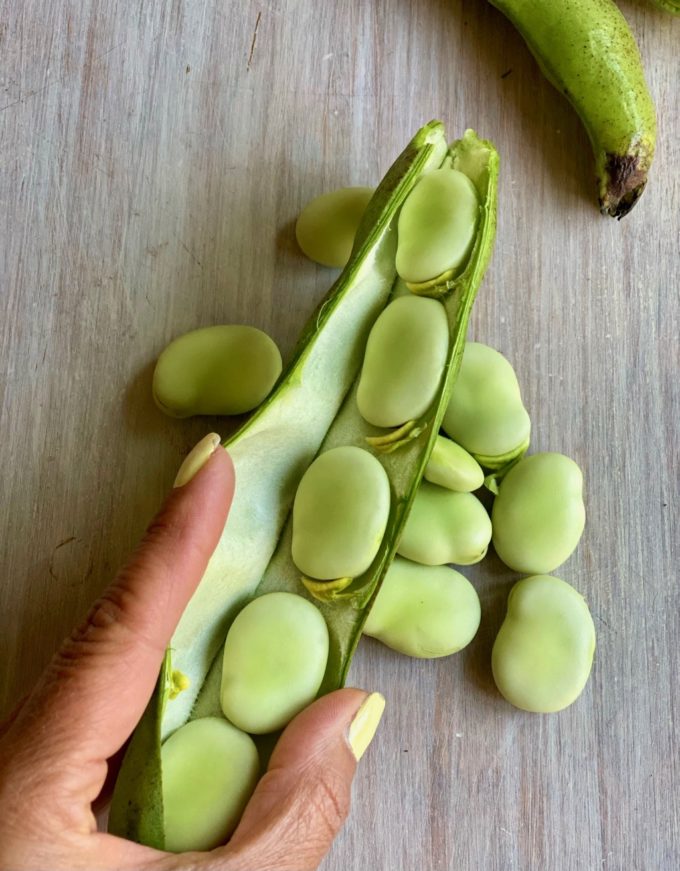
side note, when fava beans are young the outer skin is still soft, the pod/outer skin can also be consumed
If you ever there were doubts that picky eaters would eat peas or beans, plant them, water the seedlings and plants together, allow them to pick the beans, then watch them devour up before your eyes!

The garden science curriculum was wonderful in going deep into the nutritional benefits of fava beans. Fava beans are a powerhouse of nutrition!
Why are favas good for you?
- very good source of plant-based protein and fiber
- loaded with micronutrients: vitamins including a high level of folate (in the vitamin B family), minerals including manganese, iron, selenium
- low in calories yet filling
If you haven’t tried fava beans you’re in for a treat. They taste like a milder version of baby lima beans and have a nutty, less bitter, and slightly sweet pleasant flavor. Please note that it can be a challenge finding fresh fava beans as the window they are in season is very short. Fresh fava beans in the pod are in season for about two weeks in the spring around May. If you are lucky you may find fava beans in frozen or canned form, most often in middle eastern or international markets.
There are a few steps for cleaning and shelling favas from fresh fava bean pods.
Steps for preparing fresh fava beans from the pod:
- remove beans from pods
- blanch and remove outer shells (ice bath to stop cooking after a quick 1-minute blanch)
- cut to a smaller size for mixed rice
Here is a short video demonstrating how to shell fava beans from fresh fava bean pods:
If you’d like to try this recipe but are having trouble tracking down favas, fortunately, there are a few good substitutes for fava beans in this recipe.
Good substitutes for fava beans in this recipe:
- green peas
- edamame
- lima beans
My go-to fava bean substitute for this recipe is green peas. We always have them both frozen and in canned and everyone in the family likes the sweet, familiar taste of green peas. My next choice is edamame. We all really like the taste of edamame as well. Many people including Iranians substitute baby lima beans for fava beans – they are similar in appearance and texture but to me, the taste is stronger and more bitter with lima beans.
Watch this handy recipe for a visual on how to layer the parboiled rice, green peas (or favas if you are lucky to find those), dill, and spices in a big pot, preparing for the 2nd round of cooking the rice after it’s been layered and mixed.
Steps for layering rice for mixed green pea and dill Persian rice:
- pour oil along with some saffron to coat the bottom of a large pot
- layer with parboiled rice
- sprinkle in fava beans (or substitute such as green peas)
- next, add dill weed and spices
- gently stir and combine the layer
- start again and layer with parboiled rice, fava beans (or substitute such as green peas), dill, and spices
An important step when cooking layered Persian rice is to wrap the lid of the pot securely with a dish towel (paper towel also works) to secure and keep the steam inside the pot while it’s cooking. This technique helps to keep the rice fluffy – a soggy or sticky Persian rice is considered a ‘fail’! Just be sure that it is folded up and wrapped tightly away from the heat source.
The good news is that dill is relatively easy to find in markets fresh, freeze-dried, and dried as a spice. The rice tastes best with fresh herbs but I find freeze-dried to work nicely as well.
As per usual with all Iranian dishes, there are variations as to which spices are used according to the person or family’s recipe. The ‘advieh’ or spice mix is different in each Persian cook’s home. We like to keep it simple and close to the traditional version.
Spices used in our recipe:
- fresh or freeze-dried dill weed
- garlic
- saffron
- salt and pepper
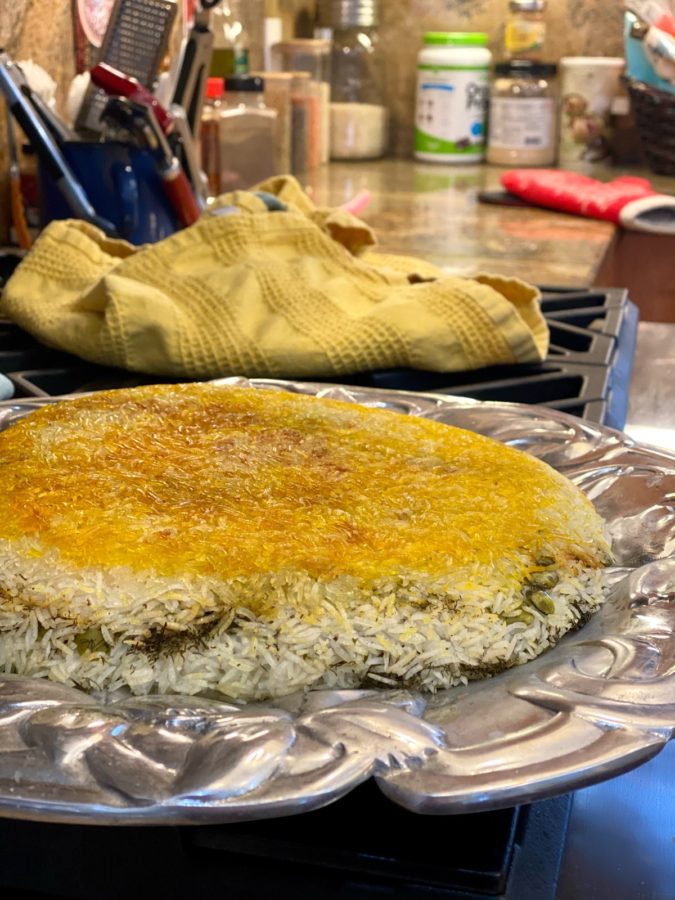
Make a bowl of Persian Cucumber Yogurt Dip | Mast O Khiar to enjoy with Persian fava bean rice. If you liked this mixed Persian rice, you’ll love Persian Green Bean Rice – check out the recipe for Loobia Polo Morgh.
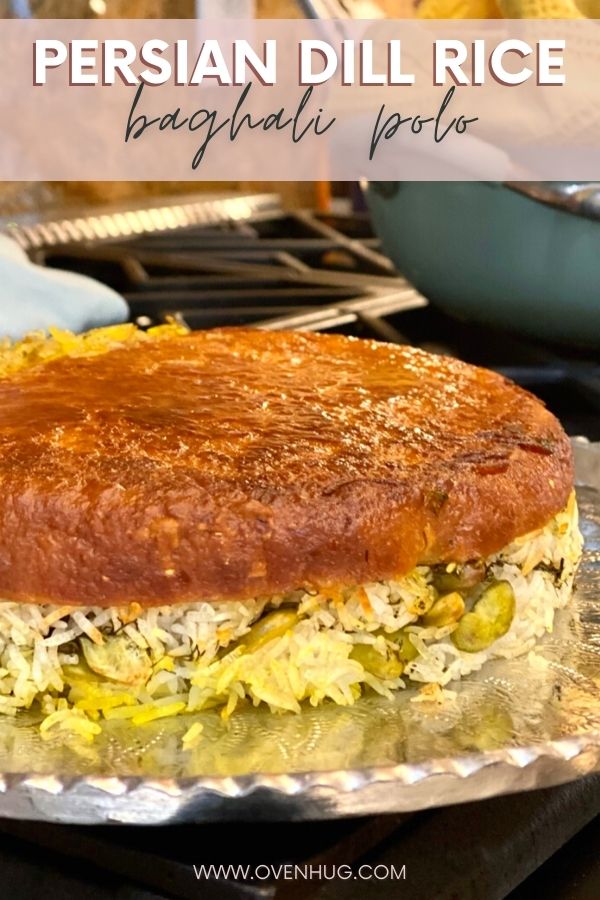
Baghali Polo | Persian Dill Rice
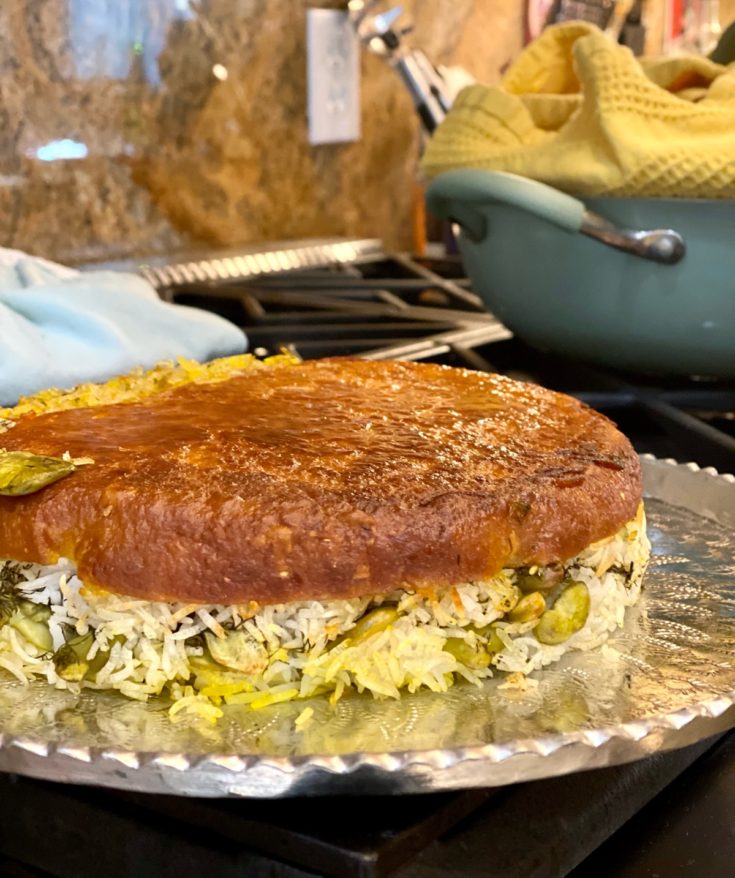
Baghali polo is a fresh, light, and delicious Persian mixed rice made with broad beans (typically fava), fresh dill, and a touch of garlic. It is a common dish in traditional Persian cuisine. When made with fresh fava beans from the pod or shell of the beans plus fresh dill weed, the process can be extremely labor-intensive (see the pic share of the day my mom insisted on making it the old fashion way with our girls). Here I share my time-saving tips and techniques for this old world classic recipe. I often substitute green peas for fava beans in this classic layered rice recipe.
Ingredients
- 3 cups uncooked long-grain basmati rice
- 12 cups water
- 1/4 cup salt
- 1 pound fresh or frozen fava beans (shelled) or green peas
- 2 to 3 tablespoons of oil
- 1/2 teaspoon of saffron, dissolved or 3 mists/sprays of saffron spray
- 2 cups finely chopped, cleaned fresh dill or 1 1/2 cups freeze dried dill
- 2 Tablespoons garlic powder mixed with 1 teaspoon salt
Instructions
- Rinse 3 cups of uncooked rice in a bowl until the discarded water rinses clear (to remove extra starches)
- Soak the rinsed rice, just covering it with water, and stir in the remaining 2 tablespoons of the salt. Allow to soak for at least 15 minutes and up to a few hours
- Fill up a large pot with water (about 12 cups) with 2 Tablespoons of the salt and bring to a boil
- Carefully drain the soaking water and transfer the rinsed rice into the boiling pot of water
- Once the water is boiling, cook for about 4-6 minutes or until the tips of a rice grain is clear (parboiling)
- Pour the parboiled rice out into a strainer and rinse with lukewarm water to rinse off some salt and to slow the cooking process
- Clean prepare the fava beans or defrost the fava beans/green peas (see recipe notes for using fava beans)
- Pour oil along with some saffron to coat the bottom of a large pot
- Layer with parboiled rice
- Sprinkle in green peas
- Next, add dill weed and garlic salt
- Gently stir and combine the layer
- Start again and layer with parboiled rice, green peas, dill, and spices until all of the rice and beans/peas have been used
- Use the back of a wooden spoon to open 3 or 4 deep holes through the layers of rice to allow the steam to evenly spread while cooking
- Cover the pot with a dishtowel, put a lid over the towel, and wrap the towel up like wrapping the lid of the pot like a present - this holds in the steam for the final cooking step of the layered rice
- If you are going for 'tadigh', start with extra oil on the bottom of the pot and cook on medium-high for about 5 minutes, then reduce heat and finish cooking the pot of rice for 45 minutes to an hour
Notes
If using fava (broad) beans, blanch the fresh or frozen fava beans for one to two minutes before layering with parboiling rice before the final cooking step. Overcooking the beans may cause the end result to be 'mushy'.
Substitutes for fava beans: green peas, edamame, baby lima beans
Fresh dill is preferable for this dish. Freeze-dried dill is a decent substitute. If using freeze-dried dill use less dill as it is chopped finely and more tightly packed and the flavor will be more concentrated.
It is an important step to use a dish towel over the pot of layered rice wrapped up over the lid of the pot during the final step of cooking the layered rice. This holds in the steam.
If you are going for 'tadigh' (the crispy rice that forms on the bottom of the rice pot), start with extra oil (the more the better to prevent burning and sticking) on the bottom of the pot and cook on medium-high for about 5 minutes, then reduce heat and finish cooking the pot of rice for 45 minutes to an hour.
Recommended Products
As an Amazon Associate and member of other affiliate programs, I earn from qualifying purchases.
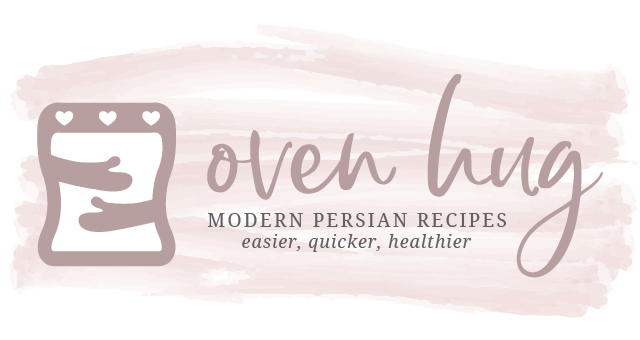



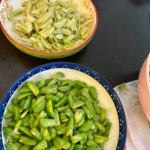







Love this Bita Joon.
XOXO
Thank you Nilou joon! xoxo
Hello Bita! My daughters love rice and peas so I’m very excited to try this recipe. I have a question for you – Once all of the layers are in the pot, do you add more water so the rice can finish cooking?
Thank you!
Hi Libby, really? That’s great! They will surely love this recipe then. Good question. You only need to add a very small amount of water once all the layers are in for the final steaming step. Sometimes I don’t add any extra water (don’t want the result to be mushy rice). The moisture from the peas and the water retained in the strands of rice should be enough to steam the rice. The oil on the bottom of the pot will help prevent burning. A little crispy rice at the bottom of the pot is considered a delicacy! Enjoy. Report back if they like it 🙂